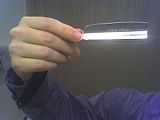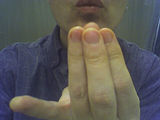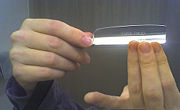Shaving against the grain on the upper lip - The Fool's Pass
| This article is a stub. You can help the Straight Razor Palace Wiki by expanding it. |
Techniques for a proper shave
Shaving should be performed once your beard area has been in contact with hot water. The warm humidity will open up your pores and soften your skin.[1]
Apply quality shaving cream or soap to your face. A shaving brush is the key to keeping your face hot and moist during this process. Not only that it softly massages your skin, it will help to lift the hairs of your beard for a better shave. The consequence here is that you'll be able to achieve a much closer shave.[2]
Using a sharp, clean razor, shave in direction that the beard grows. Assist your skin by lightly pressing into your skin near the beard area you will be shaving, prior to sliding the razor across your face with your other hand.[3]
Rinse with cold water to close the pores. Don't forget to put a skin moisturizer or after shave balm on your face immediately after shaving. This helps your skin to recover.[4]
Shaving against the grain on the upper lip
Shaving against the grain on the upper lip is listed as a clear ‘Do Not Do’, but that hasn’t stopped me.[5] After months of trying and trying and failing and failing to get my lip clean, I ventured into the dark waters of an uncertain path that no-one would even speak about let alone recommend. It’s understandable. I’ll bet there used to be old urban legends about the sailor who, while shaving with a hangover (or worse) cuts the tip of his nose off. If he were as swift as one of our member he would simply put it back on and be using it like normal later that day. When I imagine century old sailors I don’t picture them being that sharp. Sailors aside, I was adamant (as I have been since I started straight shaving) that I would NOT hurt myself so I did not proceed until I was certain that I was completely safe. I’ll start with stage one:
Using the safe heel of the blade and shaving against the grain on either side of my nose permitted me to get the two sides of my upper lip (not directly below my nose) I was able to move the razor well beyond my nose in a safe fashion and get a smooth shave over my whole upper lip except for that trouble spot, the Chaplin spot. By shaving up at an angle from the centre of my lip outward and upward past my nose as described cleaned a wider area, but still left some fuzz behind. I’ve got some seriously stubborn hairs that are very fine and sit flat against my skin. Anything except an against the grain pass will not leave my face clean. It’s that simple. I made do with that for a few weeks until it came to me. I knew how I could be safe getting right up under my nose.
Here’s the disclaimer moment: Do not try this yourself. You heard me, I said no. Of course I know you guys aren’t the types to play by the rules so when you break that one keep something else in mind. Your first objective is not to get a good shave. Getting a good shave is now your secondary objective. Avoiding all injury is now your primary goal. It should have been that way all along. If you are brave enough, or fool enough to follow me into the murky darkness, you are talking a risk!
- The three parts to the preparation
If you are doing this now yourself you might begin to see how sure I feel about not causing myself any injury. With the razor’s spine pressed gently down onto the off hand, there’s a great deal of control over where the blade is going. It’s impossible for me to imagine losing control of the blade. All that’s needed is to go slow. I don’t trouble myself with my secondary objective (good shave) too much. That happens because I happen to be shaving. I make sure that there is no chance of injury. That includes, but is not limited to;
- Keeping my balance. I don’t lean against the sink, lock my knees or shorten my lower back.
- Keeping my footing. I do not stand on an uneven, wet or otherwise uncertain landscape.
- Always knowing where the edge is and being ready to take it away from my face at all times.
- Using NO pressure.
- Stretching my lip as tightly as possible.
- Breathing evenly for maximum relaxation and attention.
I don’t know if all that’s no chance of injury, but it’s a severely limited chance of injury and I’m comfortable with that.
Citations and notes
- ↑ http://www.straightrazorplace.com/forums/downloads//ec_tmp/Muehle-Pinsel%20Shaving%20Tips%20English-German.pdf
- ↑ http://www.straightrazorplace.com/forums/downloads//ec_tmp/Muehle-Pinsel%20Shaving%20Tips%20English-German.pdf
- ↑ http://www.straightrazorplace.com/forums/downloads//ec_tmp/Muehle-Pinsel%20Shaving%20Tips%20English-German.pdf
- ↑ http://www.straightrazorplace.com/forums/downloads//ec_tmp/Muehle-Pinsel%20Shaving%20Tips%20English-German.pdf
- ↑ http://straightrazorplace.com/old_site/inthedeepend/?p=31


